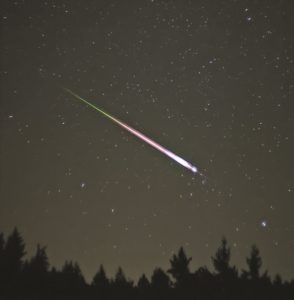When you think of November, what comes to mind? Gray clouds and biting wind? Thanksgiving? That extra hour of sleep when daylight saving time ends? For me, it’s the annual Leonid meteor shower, whose peak begins tonight, Nov. 17, and continues through the 19th.
I’ll always remember the astonishing Leonids of 2001. Bright fireballs with glowing trails streaked across the sky every two or three minutes. Some exploded, leaving behind bright filaments that twisted and faded. At its peak, thousands of Leonids per hour lit up the sky. I witnessed this storm of meteors at 2 a.m. from New York City’s Central Park with a few close friends — and hundreds of strangers.

Every year is different, and no Leonid meteor shower since 2001 has matched that display. But some scientists are predicting that 2022 could be an impressive show, especially on Friday night, Nov. 18. Before you head out to watch it, here’s some background on what meteors and meteor showers are.
In space, the distances between objects are enormous. The Moon, our natural satellite and closest neighbor, is about 220,000 miles away. The Sun is 93 million miles away. Proxima Centauri, the star closest to our own, is 4.2 light-years from us — that’s 24.7 trillion miles.
All that space is littered with stuff: molecules of hydrogen gas, specks of dust, and rocks as big as two or three feet in diameter. As Earth speeds along its orbit, we strike millions of these rocks and dust specks every day. They hit our atmosphere at 18 miles per second or faster, depending on their own trajectories. At those speeds, friction with air molecules in the atmosphere heats the objects to such high temperatures that they quickly melt and vaporize.
When we witness the fiery demise of one of these rocks from 60 miles below, we call it a meteor or a shooting star. On any night, you can see a meteor every minute or so. Things get much more exciting when Earth crosses the debris trail of a comet.
Comets are giant dirty snowballs, a frozen mix of ice, dust, and rocks that can be as large as 60 miles in diameter. Most have very long orbits and spend hundreds or thousands of years in the distant, frigid regions of the outer solar system. Some have orbits that occasionally bring them into the inner solar system — Earth’s neighborhood.
When a comet hurtles through the inner solar system and approaches the Sun, it heats up. Its outermost ice sublimates (transitions from solid directly to gas), releasing embedded dust and pebbles. Sunlight reflects off this debris trail of water vapor and rocks, and we see a comet in our night sky.
The trail of debris lingers in space for a long time after the comet has returned to the cold outer dark. When Earth plunges through one of these trails, which we do about 30 times per year, we see a meteor shower, with many more shooting stars occurring than on a typical night.
Many of these regularly recurring meteor showers are more like a misty drizzle. Only a few are true showers of shooting stars. The Leonids, whose parent body is Comet 55P/Tempel-Tuttle, are usually a modest affair. In a normal year, you’ll see 10 to 15 Leonids per hour, brighter and with longer trails than your typical shooting star.
What about those predictions of increased activity? Each time a comet passes by it leaves a new debris trail. And some trails are denser than others. In 2001, the year I saw the dramatic shower, Earth passed through the debris trail that Comet 55P/Tempel-Tuttle shed in 1998. Scientists accurately predicted that dramatic display.
Astronomers calculate that in the early hours of Nov. 19, Earth will pass through the debris trail 55P/Tempel-Tuttle left in the year 1733. We could see a burst of 250 to 300 meteors per hour beginning around 1 a.m. and continuing to sunrise.
There are those November clouds I mentioned earlier. If it’s cloudy that night, we won’t see a spectacular Leonid show. If it’s any consolation, there are predictions for above-average Leonid activity related to other debris trails, some at around 2 a.m. on Nov. 18 and some before dawn on Nov. 21.
To see the Leonids, just step outside after dark and look up. You’ll have better luck the later you go outside. To see the possible burst on the 19th, you’ll need to venture out after midnight. Dress warmly, be patient, and keep your eyes on the sky. The best meteors have a habit of appearing the moment you turn to the person next to you and say, “I haven’t seen any meteors.” Clear skies!
